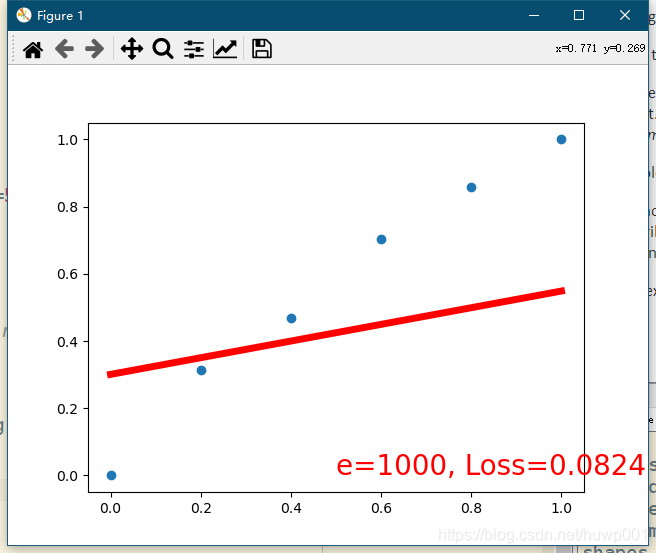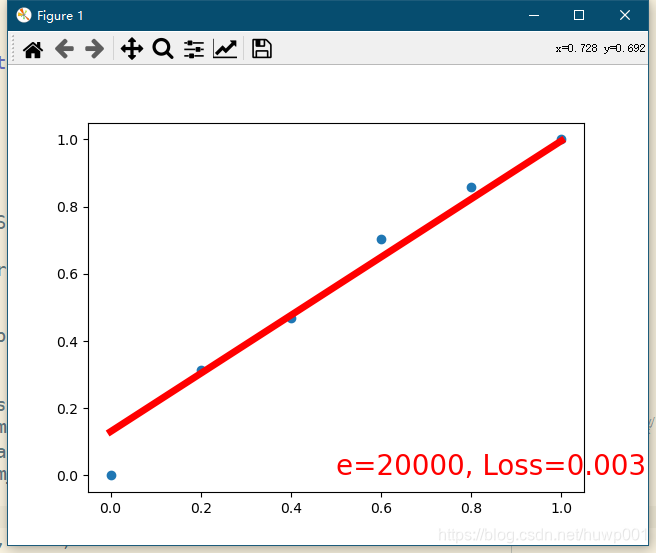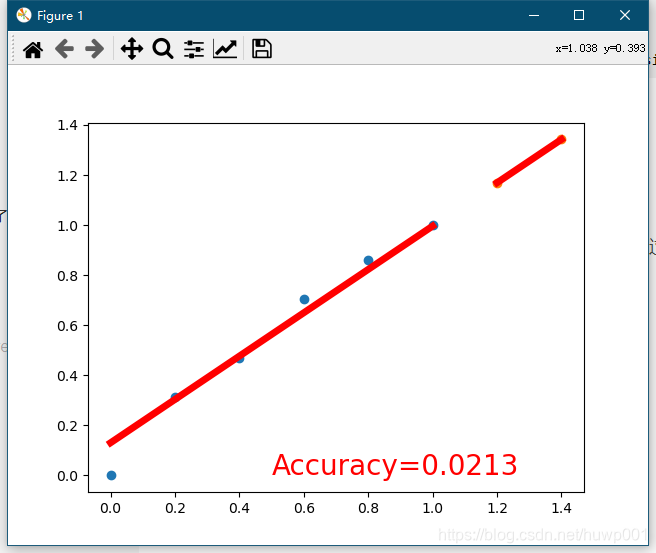前言
茴字有13种写法其实才是深入学习的有效方式
上一篇文章使用 tensorflow 初步 完成了线性回归,继续尝试使用建模的方式优化代码,并将训练的结果保存了下来。
题目
考虑一个实际问题,某城市在 2013 年 - 2018 年的房价如下表所示:
| 年份 | 2013 | 2014 | 2015 | 2016 | 2017 | 2018 |
|---|---|---|---|---|---|---|
| 房价 | 12000 | 14000 | 15000 | 16500 | 17500 | 18400 |
现在,我们希望通过对该数据进行线性回归,即使用线性模型 y = ax + b 来拟合上述数据,此处 a 和 b 是待求的参数。
环境
开发环境比较简单,安装 最新 anaconda 即可, 我安装的版本默认内置 python 3.8。 使用Spyder 执行代码, spyder默认不能跑plt 图像界面,前往 修改设置即可。
打开 Anaconda Prompt 命令行,安装 tensorflow
pip install -i https://pypi.tuna.tsinghua.edu.cn/simple tensorflow
分析
优化代码的目的是去掉一些自行撰写的部分,使用tensorflow 内置的模块来替代。
- 损失函数 更换为
losses = tf.losses.MeanSquaredError()
loss = losses(y_pred, y) # 传入 推导的值,标签值
loss = tf.reduce_mean(loss) # 求和
- 梯度的计算 更换为
with tf.GradientTape() as tape:
grads = tape.gradient(loss, model.variables) # 使用 model.variables 这一属性直接获得模型中的所有变量
- 优化器 更换为
# 优化器 随机梯度下降法(SGD)
optimizer = tf.keras.optimizers.SGD(learning_rate=5e-4)
optimizer.apply_gradients(grads_and_vars=zip(grads, model.variables))
完整的训练源码如下:
# -*- coding: utf-8 -*-
"""
Created on Sun Feb 21 21:04:10 2021
@author: huwp001
Dependencies:
tensorflow: 2.0
matplotlib
numpy
使用 tensorflow 建立模型 进行梯度下降训练。
"""
import os
os.environ["CUDA_DEVICE_ORDER"] = "PCI_BUS_ID"
os.environ["CUDA_VISIBLE_DEVICES"] = "-1"
import tensorflow as tf
import numpy as np
import matplotlib.pyplot as plt
"""
原始数据 X_raw, y_raw
"""
X_raw = np.array([2013, 2014, 2015, 2016, 2017, 2018], dtype=np.float32)
y_raw = np.array([12000, 14000, 15000, 16500, 17500, 18400], dtype=np.float32)
"""
进行归一化,转换为了 0,1 之间的值
"""
X = (X_raw - X_raw.min()) / (X_raw.max() - X_raw.min())
y = (y_raw - y_raw.min()) / (y_raw.max() - y_raw.min())
X = X.reshape(-1,1)
y = y.reshape(-1,1)
X = tf.constant(X)
y = tf.constant(y)
# 定义模型
class MyLinear(tf.keras.Model):
def __init__(self):
super().__init__()
self.dense = tf.keras.layers.Dense(
units=1,
activation=None,
kernel_initializer=tf.zeros_initializer(),
bias_initializer=tf.zeros_initializer()
)
def call(self, input):
output = self.dense(input)
return output
model = MyLinear()
num_epoch = 20000
# 优化器 随机梯度下降法(SGD)
optimizer = tf.keras.optimizers.SGD(learning_rate=5e-4)
# loss 函数:MSE
losses = tf.losses.MeanSquaredError()
for e in range(num_epoch):
with tf.GradientTape() as tape:
y_pred = model(X) # 调用模型 y_pred = model(X) 而不是显式写出 y_pred = a * X + b
loss = losses(y_pred, y)
loss = tf.reduce_mean(loss)
grads = tape.gradient(loss, model.variables) # 使用 model.variables 这一属性直接获得模型中的所有变量
optimizer.apply_gradients(grads_and_vars=zip(grads, model.variables))
if e % 50 == 0 or e==num_epoch-1:
plt.cla()
plt.scatter(X, y)
plt.plot(X, y_pred, 'r-', lw=5)
plt.text(0.5, 0, 'e=%d, Loss=%.4f' % (e, loss), fontdict={'size': 20, 'color': 'red'})
plt.pause(0.1)
# 保存训练得到的参数
model.save_weights('model3.weight')
为方便展示,使用plt模块增加了推导进度的显示,可以看到 我们从一个 横线 y=0*x+0, 推导得到 最终的结果。
运行
执行程序开始推导,红线是初始 y=ax+b, 且 a=b=0, 由于使用了model,暂时获取不到 a,b ,这个待研究。

循环20000次后结果,红线比较完美的穿过数据点。感觉学习的效率比上两篇差。自己写函数可能效率还是高一些。

训练的结果保存了下来,然后下一步我们进行模型评估。
模型评估代码如下:
# -*- coding: utf-8 -*-
"""
Created on Mon Feb 22 17:49:28 2021
@author: Administrator
Dependencies:
tensorflow: 2.0
matplotlib
numpy
读取训练好的模型,进行模型评估
"""
import tensorflow as tf
import numpy as np
import matplotlib.pyplot as plt
"""
原始数据 X_raw, y_raw
"""
X_raw = np.array([2013, 2014, 2015, 2016, 2017, 2018], dtype=np.float32)
y_raw = np.array([12000, 14000, 15000, 16500, 17500, 18400], dtype=np.float32)
X2_raw = np.array([2019, 2020], dtype=np.float32)
"""
进行归一化,转换为了 0,1 之间的值
"""
X = (X_raw - X_raw.min()) / (X_raw.max() - X_raw.min())
y = (y_raw - y_raw.min()) / (y_raw.max() - y_raw.min())
X = X.reshape(-1,1)
y = y.reshape(-1,1)
X = tf.constant(X)
y = tf.constant(y)
X2 = (X2_raw - X_raw.min()) / (X_raw.max() - X_raw.min())
X2 = X2.reshape(-1,1)
X2 = tf.constant(X2)
class MyLinear(tf.keras.Model):
def __init__(self):
super().__init__()
self.dense = tf.keras.layers.Dense(
units=1,
activation=None,
kernel_initializer=tf.zeros_initializer(),
bias_initializer=tf.zeros_initializer()
)
def call(self, input):
output = self.dense(input)
return output
model = MyLinear()
model.load_weights('model3.weight')
# 先对原始数据进行 回归验证
y_pred = model.predict(X)
metrics_f = tf.keras.metrics.mean_squared_error(y, y_pred)
loss = tf.reduce_sum(metrics_f);
print("test accuracy: " , loss)
# 对 新数据进行预测
y_pred2 = model.predict(X2)
plt.cla()
plt.scatter(X, y)
plt.plot(X, y_pred, 'r-', lw=5)
plt.scatter(X2, y_pred2)
plt.plot(X2, y_pred2, 'r-', lw=5)
plt.text(0.5, 0, 'Accuracy=%.4f' % (loss), fontdict={'size': 20, 'color': 'red'})
运行代码,得到如图:

注意我这里先读取模型,再次验证了原始数据,然后对新数据X2 进行预测,展示如图。预测的结果从图像上还是可信的。
总结
和上一篇相比,使用了Model,完全隐藏了 手动计算梯度等过程,函数表达式也看不到了,好在结果基本一致。
下一篇继续就一元一次函数学习 tensorflow 的写法。
参考文章:
简单粗暴 tensorflow2 前往





 本文介绍了使用TensorFlow进行线性回归的建模优化,包括损失函数、梯度计算和优化器的改进。通过20000次迭代训练,模型能较好地拟合数据点,但效率可能低于手动实现。最后,模型被用于验证原始数据和新数据的预测,结果显示预测效果可信。
本文介绍了使用TensorFlow进行线性回归的建模优化,包括损失函数、梯度计算和优化器的改进。通过20000次迭代训练,模型能较好地拟合数据点,但效率可能低于手动实现。最后,模型被用于验证原始数据和新数据的预测,结果显示预测效果可信。

















 被折叠的 条评论
为什么被折叠?
被折叠的 条评论
为什么被折叠?








